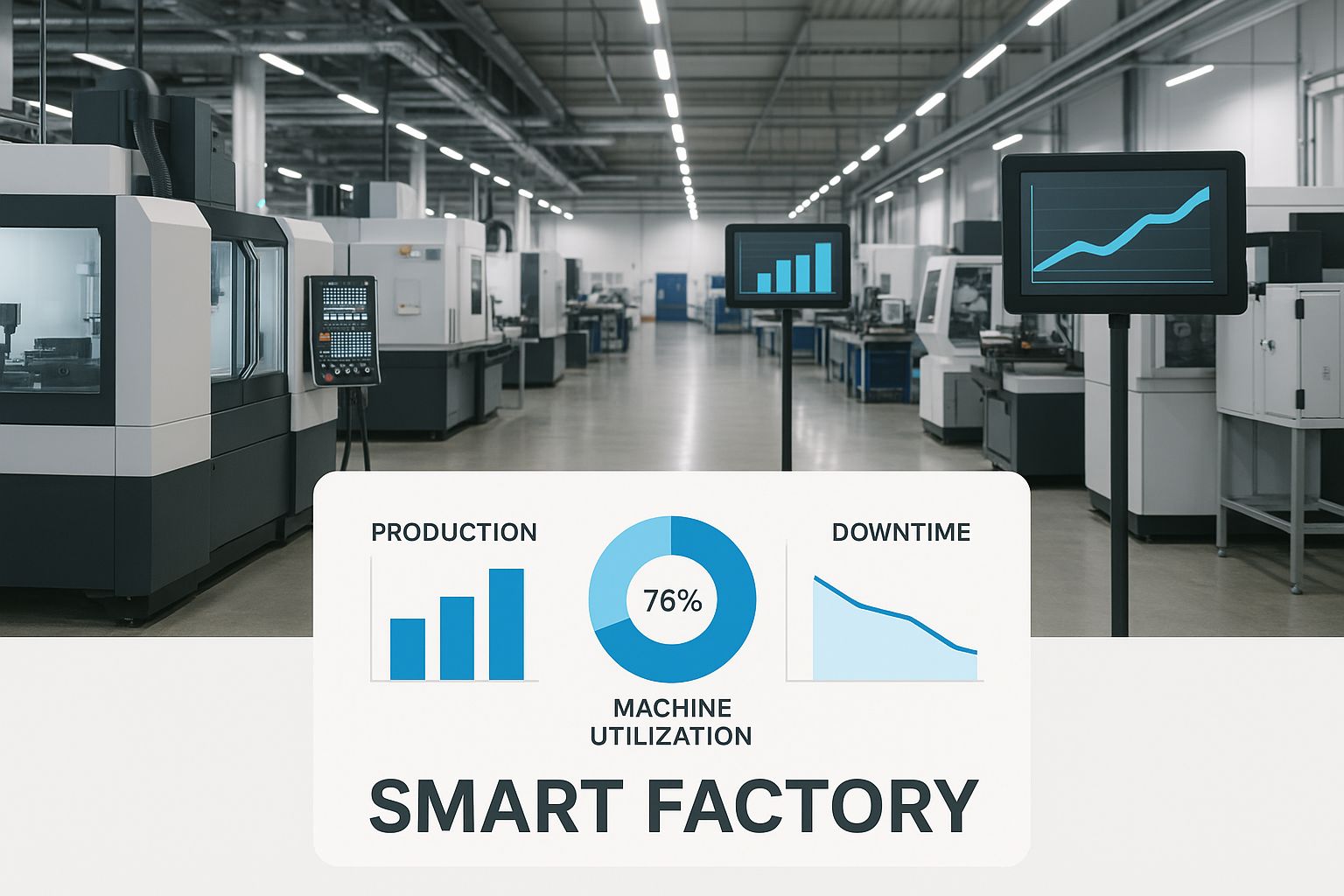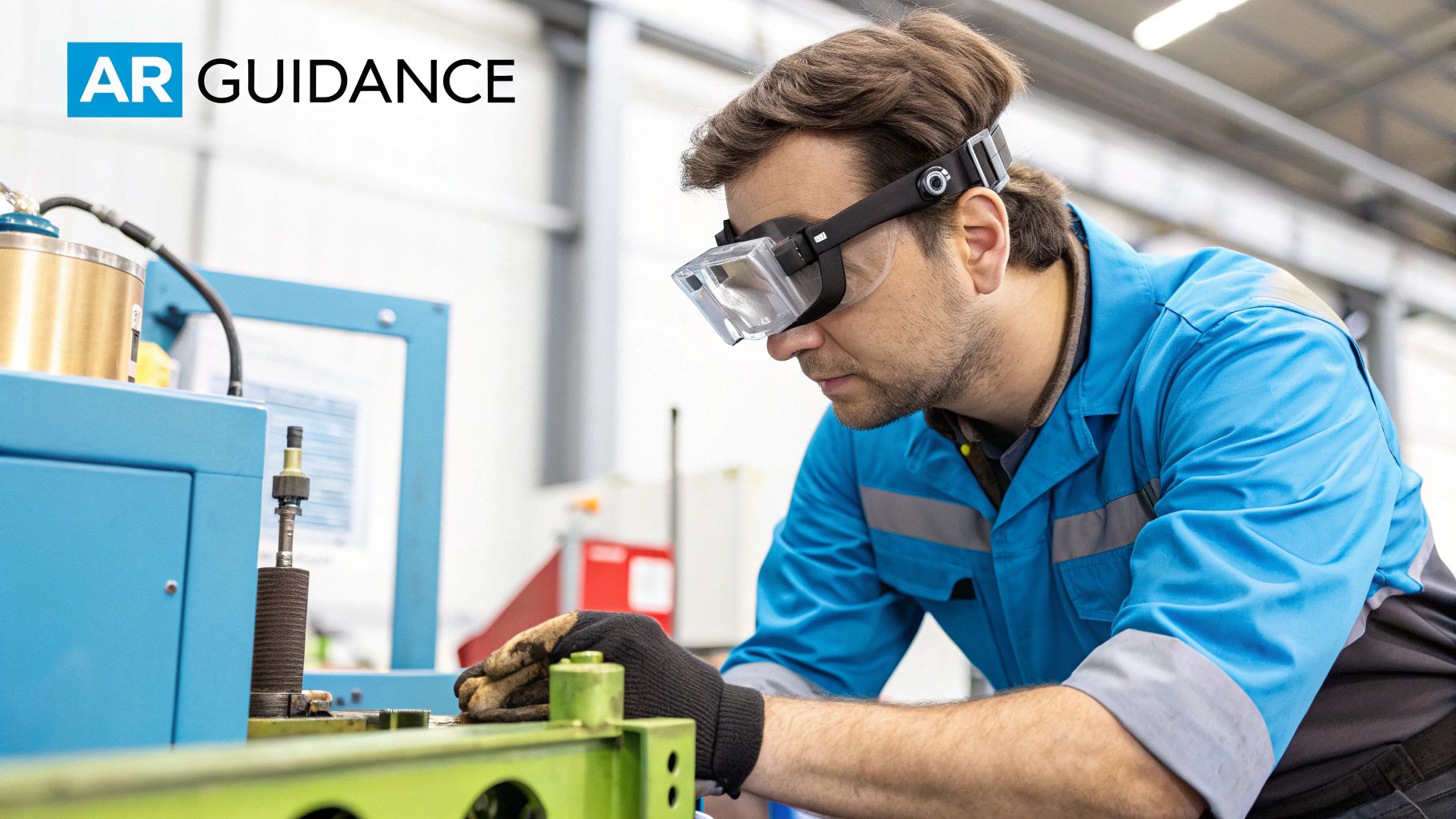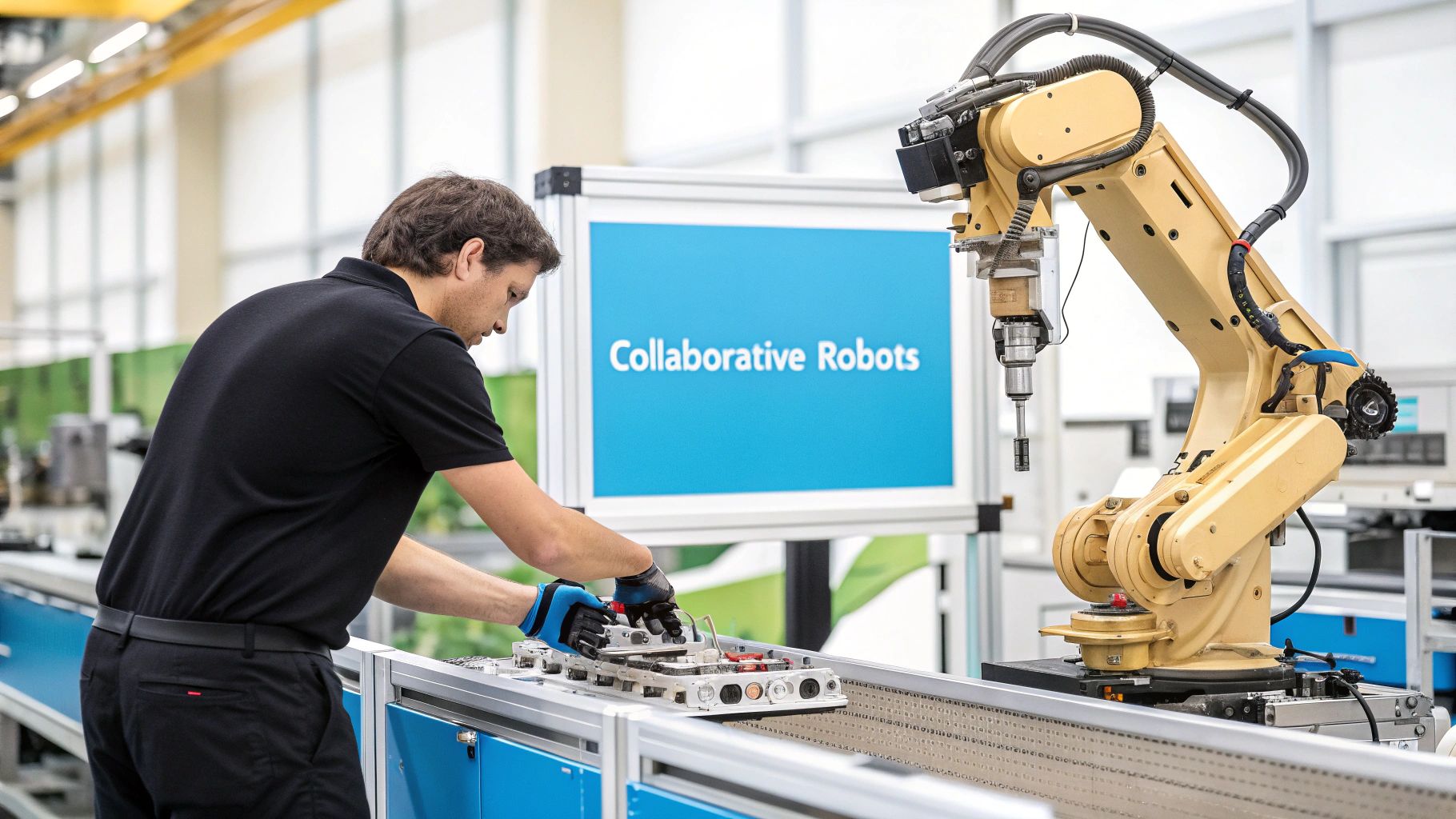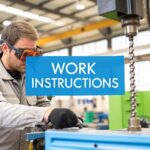Top Innovations in Manufacturing Industry Guide
The hum of old-school assembly lines is fading. In its place, something far more intelligent is emerging. Think of it as a convergence—a perfect storm of technologies like Artificial Intelligence (AI), the Internet of Things (IoT), advanced robotics, and immersive tools like augmented reality.
These aren't just siloed upgrades. They're working together, turning traditional factories into interconnected, intelligent ecosystems we now call 'smart factories.' It's a fundamental shift that enables a level of efficiency, prediction, and agility that was just a pipe dream a decade ago.
The Next Industrial Revolution Is Here
If you step inside a modern factory today, you'll feel it. The old, predictable rhythm is gone, replaced by the dynamic pulse of Industry 4.0. This isn't just about bolting on new tech; it's a total reimagining of how we design, build, and ship products. These core innovations in manufacturing industry are building an entirely new operational reality.
This guide will cut through the buzzwords to show you what's really happening on the ground. We’ll break down how forces like AI and robotics are coming together to create smart factories that are more resilient, efficient, and adaptive than ever. And it matters—for every dollar spent in manufacturing, it creates $2.69 in economic activity, making these leaps forward vital for global growth.
A New Era of Production
So, what is this "Fourth Industrial Revolution," or Industry 4.0? At its heart, it's about giving a factory a brain and a central nervous system. It’s the seamless blend of digital technology with the physical world of production. This creates systems that can monitor themselves, flag problems before they happen, and even adjust on the fly with minimal human input.
The key drivers behind this shift are pretty straightforward:
- Data-Driven Decisions: Instead of guessing, managers can use real-time data streaming from machinery to schedule proactive maintenance and fine-tune workflows.
- Enhanced Connectivity: IoT devices act like the factory's nerve endings, linking everything from a single sensor on a conveyor belt to the entire global supply chain.
- Intelligent Automation: AI and robotics take over the dangerous, repetitive, or mind-numbingly complex tasks. This doesn't replace people; it frees them up to handle more creative, high-value work.
Today's manufacturing landscape demands a real strategy for technology. The goal isn't just to add gadgets—it's to build a more agile and responsive operation that can turn industry challenges into a massive competitive advantage.
Building a Foundation for Success
Getting this right is a journey, not a weekend project. It takes a clear vision and a real commitment to evolving your tech and your team in tandem. A successful transition means understanding what each innovation actually does and, more importantly, how they all fit together to create real value.
You can learn more about building a solid plan by exploring proven industrial best practices.
Think of this guide as your roadmap. We’ll explore how these tools are moving from theory to reality, delivering measurable results on factory floors around the world right now.
How AI and IoT Create the Smart Factory

The image above gives you a glimpse into the modern factory floor—a place where physical machinery and digital intelligence are no longer separate. They've merged to create the 'Smart Factory,' a dynamic environment where raw data gets turned into real-world efficiency.
The best way to understand the smart factory is to think of it as two core components working in perfect harmony.
First, you have the Internet of Things (IoT), which acts like the factory's central nervous system. It’s a huge network of sensors, cameras, and connected devices installed everywhere, from the assembly line right down to individual warehouse shelves. These devices are constantly collecting a massive amount of real-time data on everything—machine temperatures, production speed, energy use, you name it.
But all that data is just noise until something makes sense of it.
That’s where Artificial Intelligence (AI) comes in, serving as the factory’s brain. AI algorithms take that endless stream of IoT data and turn it into something genuinely useful. It’s the engine that finds hidden patterns, flags tiny anomalies, and makes smart decisions to keep the entire operation running smoothly.
From Reactive Repairs to Predictive Maintenance
One of the most powerful ways this AI and IoT partnership comes to life is in predictive maintenance. For decades, maintenance was either reactive (fix it after it breaks) or preventive (service it on a schedule, needed or not). Both are costly and create a ton of downtime.
A smart factory flips that script entirely. IoT sensors keep a constant watch on machine health, tracking vibrations, temperatures, and other key performance metrics. The AI then crunches this data to predict when a part is likely to fail, often weeks in advance.
Instead of scrambling when a machine grinds to a halt, maintenance teams get an alert to service a specific component at the most optimal time. This shift from reactive to proactive maintenance is a massive leap forward.
This proactive approach is one of the core innovations in manufacturing industry that pays for itself. Being able to see failures coming minimizes surprise shutdowns and gets more life out of your expensive equipment. To dig deeper into this, check out our guide on the benefits of predictive maintenance in manufacturing.
Enhancing Quality Control with AI Vision
Another huge win is in quality control. Human inspectors are good, but they're still human. Fatigue sets in, and on a high-speed line, it's impossible to catch everything. This is where AI-powered vision systems really shine.
High-resolution cameras capture images of every single product coming off the line. AI algorithms then analyze those images in a split second, spotting defects that are often invisible to the human eye—like microscopic cracks, subtle color variations, or tiny misalignments.
The precision is a game-changer. These kinds of smart manufacturing solutions have been shown to reduce defect rates by around 30% and slash downtime by as much as 50%.
Below is a quick summary of the key technologies driving this shift.
Key Innovations Driving the Smart Factory
This table breaks down the core technologies that are making the smart factory a reality, outlining what they do and the tangible benefits they bring to the production floor.
| Technology | Primary Function | Key Benefit |
|---|---|---|
| Artificial Intelligence (AI) | Analyzes vast data sets to identify patterns, predict outcomes, and automate decisions. | Enables predictive maintenance, improves quality control, and optimizes production schedules. |
| Internet of Things (IoT) | Uses sensors and connected devices to collect real-time data from machinery and processes. | Provides a live, granular view of the entire factory floor for better monitoring and control. |
| Robotics & Automation | Deploys robots to perform repetitive, precise, or hazardous tasks on the assembly line. | Increases production speed, ensures consistent quality, and enhances worker safety. |
| Digital Twins | Creates a virtual, real-time simulation of a physical asset, process, or entire factory. | Allows for testing, simulation, and process optimization without disrupting physical operations. |
| Additive Manufacturing (3D Printing) | Builds objects layer-by-layer from digital models, ideal for prototypes and custom parts. | Speeds up product development, enables on-demand part creation, and reduces material waste. |
| Augmented & Virtual Reality (AR/VR) | Overlays digital information onto the real world (AR) or creates immersive virtual environments (VR). | Used for complex assembly guidance, remote expert assistance, and realistic employee training. |
These technologies don't work in isolation; their real power is unlocked when they are integrated, creating a cohesive and intelligent manufacturing ecosystem.
Optimizing the Entire Production Flow
Ultimately, the goal is to improve overall operational effectiveness, and that extends beyond the factory walls. AI can analyze data from the entire ecosystem—from raw material suppliers to final shipping logistics—to find opportunities for improvement.
This leads to smarter inventory management and more resilient operations that can adapt to disruptions. For a closer look, this guide offers excellent strategies to improve supply chain efficiency.
When you combine AI and IoT, you create a self-optimizing production environment. It’s a system that learns and gets progressively more efficient, responsive, and reliable over time.
Using AR and VR on the Factory Floor

While AI and IoT manage data behind the scenes, Augmented Reality (AR) and Virtual Reality (VR) are transforming how people physically interact with machinery. These immersive technologies have moved beyond consumer applications and are now delivering significant value in the demanding environment of modern manufacturing.
Though often discussed together, AR and VR serve distinct and powerful functions.
Virtual Reality (VR) creates a fully immersive, computer-generated simulation, replacing a user's real-world surroundings. Augmented Reality (AR), in contrast, enhances the real world by overlaying digital information—such as text, diagrams, or 3D models—onto a user's view of their physical environment.
Enhancing Skills with Virtual Reality Training
Training new staff on complex, expensive, or potentially hazardous equipment presents a significant challenge in manufacturing. VR provides a highly effective solution by creating a risk-free digital environment where employees can learn, practice, and master skills without real-world consequences.
Consider a new technician learning a complex assembly procedure. A VR-based training module allows them to:
- Practice complex procedures repeatedly without consuming raw materials or occupying production-critical machinery.
- Simulate realistic equipment failures in a controlled setting, learning troubleshooting protocols without causing actual downtime or safety risks.
- Operate virtual heavy machinery or delicate instruments to build muscle memory and confidence before engaging with physical equipment.
This immersive approach reduces training time and helps prevent costly errors and potential injuries that can occur when inexperienced personnel learn on live equipment.
VR training builds competence and confidence simultaneously. By providing a perfect digital replica of the workspace for unlimited practice, it helps develop a more skilled and efficient workforce from the start.
Streamlining Workflows with Augmented Reality
While VR excels in off-the-floor training, AR provides powerful, on-the-job support directly at the point of need. Delivered through smart glasses or mobile devices, AR solutions act as a digital assistant, providing context-aware information to front-line workers.
Imagine a maintenance technician addressing a complex equipment breakdown. Instead of consulting a paper manual or returning to a desktop terminal, they can use AR glasses that overlay critical information directly onto the machinery.
Practical use cases for this real-time guidance include:
- Step-by-step assembly or repair instructions that visually highlight which components to address next.
- Live data from IoT sensors, displaying real-time temperature or pressure readings on the specific part being inspected.
- Remote expert assistance, where a senior specialist can see what the on-site technician sees and provide guidance by annotating their field of view.
This integration of digital information into the physical workspace empowers employees to perform complex tasks with greater accuracy and speed. To learn more about how companies are leveraging this technology, explore these practical applications of augmented reality in manufacturing.
AR tools demonstrably reduce human error, shorten service times, and help bridge the skills gap by delivering expert knowledge directly to the front line, making complex industrial tasks more manageable and precise.
The Real Impact of Advanced Robotics and Automation

The classic picture of a factory robot—a massive arm cordoned off behind a safety cage—is starting to look like a black-and-white photo from a bygone era. Today's robotics are smarter, nimbler, and far more collaborative. This isn't just an upgrade; it's a fundamental shift in how automation works, moving from a tool of brute force to a sophisticated partner for human workers.
The new generation of automation isn't here to replace people. It's designed to augment their skills, taking over the repetitive, physically draining, or mind-numbingly precise tasks that humans just aren't built for. This frees up skilled employees to do what they do best: solve complex problems, improve processes, and think creatively.
The Rise of Collaborative Robots
One of the biggest game-changers has been the arrival of collaborative robots, or "cobots." These machines are built with advanced sensors and safety protocols that let them work right alongside human teams, no cages required. They’re no longer isolated assets but are woven directly into the daily workflow on the factory floor.
Cobots are at their best in jobs that need both a human touch and robotic consistency. Picture a scenario where a skilled worker delicately places components while a cobot follows behind, tightening every screw to the exact same torque, thousands of times a day. It’s a partnership that boosts efficiency and saves workers from repetitive strain injuries.
Infusing Robots with Intelligence
What truly elevates modern robotics is the infusion of Artificial Intelligence. AI gives these machines the ability to "see" and "think," turning them from pre-programmed drones into adaptive systems that can react to a constantly changing environment.
AI-powered vision systems, for example, allow a robotic arm to spot, identify, and pick up different items from a moving conveyor belt—a feat that was pure science fiction for older automation. This intelligence also lets robots handle incredibly detailed quality control, using high-res cameras to scan for microscopic defects far beyond what the human eye can catch.
By combining the tireless precision of robotics with the analytical power of AI, manufacturers can create a production environment that is not just faster, but fundamentally smarter and more reliable.
The numbers back this up. Today, 60% of manufacturers are already using robotic automation to get more done, reporting productivity gains of around 25%. It's a clear signal that smarter, more integrated automation is becoming the new standard.
Real-World Applications in Motion
These advanced robots aren't just concepts; they're already on the factory floor delivering real results. Two key examples are making a huge difference:
- Autonomous Mobile Robots (AMRs): Think of these as super-smart, self-driving carts. They navigate busy factory floors without needing fixed tracks, using sensors and AI to map their surroundings, dodge obstacles, and deliver materials exactly where they need to go, right on schedule.
- AI-Driven Assembly and Finishing: In industries where precision is everything, AI-guided robots are indispensable. From welding car frames with perfect consistency to polishing delicate surfaces, these machines perform complex motions flawlessly every time. The level of detail is incredible—similar to high-tech, computer-guided sculpting, creating permanent, intricate marks that no human hand could replicate.
By deploying these intelligent systems, manufacturers are building a more agile and resilient operation. They're not just automating tasks; they're creating a new kind of factory where human and machine skills blend to hit new heights of productivity and innovation.
Weaving Digital Threads into Physical Realities: Digital Twins and Additive Manufacturing
Two of the most profound shifts in manufacturing right now are Digital Twins and Additive Manufacturing. They might sound like separate concepts, but they work hand-in-hand, creating a powerful feedback loop between digital design and physical reality.
Think of it like this: you have a perfect, live virtual replica of your entire production line running on a computer. This isn't just a static 3D model; it's a Digital Twin. It's constantly fed real-time data from IoT sensors attached to your physical machinery, so it mirrors the exact condition and performance of its real-world counterpart.
This gives you a risk-free digital sandbox. Engineers can run simulations, test process changes, or predict how a machine will behave under stress—all without ever touching the actual factory floor.
Simulating Tomorrow's Production, Today
The real power of a digital twin is its ability to answer "what if" questions with stunning accuracy. What happens if we crank up the line speed by 10%? What if a specific component starts to overheat? The simulation spits out data-driven answers, helping your team fine-tune performance and head off failures before they ever happen.
This is exactly why adoption is taking off. Projections show that 70% of manufacturers will be using digital twin technology by 2030, a move expected to slash development costs by a hefty 15%.
A digital twin is like giving your operations a crystal ball. It lets you see the future impact of today's decisions, swapping guesswork for strategic advantage and enabling continuous improvement without the physical risks.
From Digital Models to Physical Parts
This is where the second piece of the puzzle, Additive Manufacturing, slots in perfectly. You probably know it as 3D printing, but the technology has evolved far beyond making simple prototypes. Today, it’s a legitimate and powerful production method.
Instead of traditional "subtractive" manufacturing—where you cut material away from a solid block—additive manufacturing builds objects layer by intricate layer, directly from a digital file. This unlocks some game-changing benefits:
- Mind-Bending Geometries: It can create incredibly complex, lightweight, and strong parts that are simply impossible to make with conventional tools.
- On-Demand Inventory: Why keep a massive warehouse of spare parts? Companies can now print replacements or custom tools as needed, cutting inventory costs to the bone.
- Warp-Speed Prototyping: New designs can be printed and tested in hours or days instead of weeks, radically accelerating the entire product development cycle.
Connecting the Digital to the Physical
The real magic happens when you bring these two innovations together. A new part can be designed, tweaked, and stress-tested to perfection inside the digital twin environment. Once the simulation confirms the part's integrity and performance, that exact digital file is sent straight to a 3D printer for production.
It creates a seamless, closed-loop flow from concept to creation. A virtual model drives the creation of a physical object, and data from that physical object can then be fed back into the digital twin for even more refinement. To see how companies are already doing this, check out these real-world digital twin examples.
Together, digital twins and additive manufacturing are a powerful duo making the industry more agile, efficient, and responsive. They empower companies to innovate faster, cut waste, and build better products with a level of precision that was once just a far-off dream.
A Practical Guide to Implementing New Technology
So, you’re sold on the potential of these powerful manufacturing innovations. Now what? The biggest mistake we see is companies getting dazzled by a shiny new tool—a robot, an AI platform, a set of AR goggles—and buying it without a clear plan.
Real progress isn't about buying the latest gadget; it's about solving a specific, painful problem. That’s why the best approach is to think small, at least at first. Forget the massive, factory-wide overhaul for now.
Instead, pick one area and launch a focused pilot project. This lets you prove the tech’s value on a small scale, build momentum, and learn from your mistakes before you sink a ton of money into a full-scale rollout. It’s a low-risk way to show a clear return on investment and get everyone from the shop floor to the C-suite on board.
It’s All About People and Process
Look, technology is just a tool. It’s the people using it who make it work. Your goal shouldn’t be to replace your team but to give them superpowers. When you bring in AI, robotics, or AR, you have to commit just as much to training your people.
Invest in programs that teach your team how to work with the new automated systems, not just operate them. This means showing them how to interpret the data, spot new opportunities, and focus on the kind of creative problem-solving that machines can’t do.
According to the National Association of Manufacturers (NAM), getting your company culture and leadership ready for this shift is non-negotiable. You can dig into their research on key manufacturing trends to see why.
The most successful implementations occur when technology serves the people, not the other way around. A well-trained, confident workforce is the engine that drives a successful digital transformation, turning sophisticated tools into measurable productivity gains.
When you invest in your team’s skills, you build a culture that isn't afraid of change—you create one that thrives on it.
Building a Rock-Solid Foundation
Finally, none of these advanced systems will do you any good if they’re built on a shaky foundation. Before you deploy a single new sensor, you have to take a hard look at your existing infrastructure.
Can your network actually handle the massive flood of data from thousands of IoT devices? Are your cybersecurity protocols ready to defend against a whole new set of threats? These aren't afterthoughts; they're prerequisites.
A practical roadmap for getting this done should look something like this:
- Define Your "Why": Pinpoint a real business challenge. Is it unplanned downtime? Poor quality control? Find the problem first, then choose the technology that solves it.
- Run a Pilot Program: Pick a single production line or process to test your new solution. Track everything and measure its impact with clear KPIs.
- Train Your Team: Create a hands-on training plan that gives employees the skills and confidence they need to master the new tools.
- Strengthen Your Infrastructure: Upgrade your network, beef up your data storage, and patch up your security to handle the new demands of a truly connected factory.
Following these steps methodically helps you sidestep the common traps, get the most bang for your buck, and lay the groundwork for a transformation that actually lasts.
Got Questions About These Manufacturing Innovations? We Have Answers.
As leaders start to dig into the potential of new industrial tools, a few key questions always seem to pop up. Let's tackle them head-on, because clearing up the confusion is the first step toward making these powerful tools work for you.
One of the first things people ask is about the real difference between plain old automation and a truly smart factory. Think of it this way: traditional automation is like programming a robot arm to do one single task over and over again, perfectly. A smart factory, on the other hand, uses a whole network of interconnected systems that actually learn, adapt, and make their own decisions based on what’s happening right now.
I’m a Small Business. Where Do I Even Start?
For smaller shops, the idea of a massive digital overhaul can sound intimidating and frankly, way too expensive. But here’s the thing: you don’t have to boil the ocean. The smartest way to start is by picking one clear, specific business problem.
Don't begin by asking, "How can we use AI?" Instead, ask, "What’s our biggest source of downtime, and is there a piece of tech that can fix it?" This problem-first mindset ensures every dollar you spend is tied directly to a real return.
Your best bet is often a small-scale pilot project zeroed in on a single pain point. It could be as simple as putting IoT sensors on one critical machine to see failures coming before they happen. Or maybe it’s using an AR tool to guide technicians through a tricky assembly process for just one product line. Start small, prove the value, and then scale.
How Do These Innovations Help Us Be More Sustainable?
Another big question we hear is how all this new tech fits with the growing pressure to be greener and support a circular economy. The connection is more direct—and more powerful—than you might think. These tools aren't just about making things faster; they're essential for building a more responsible operation.
- AI-Optimized Energy Use: Imagine AI algorithms constantly analyzing your factory's energy use, spotting tiny inefficiencies you’d never see, and finding ways to cut waste and shrink your carbon footprint.
- Drastically Reduced Material Waste: Additive manufacturing (that’s 3D printing) builds parts layer by layer, using only the exact material required. This slashes the amount of scrap metal and plastic left on the floor compared to old-school subtractive methods.
- True Circularity: Digital Product Passports, built on IoT and blockchain, can track a product's entire journey from creation to retirement. This makes it infinitely easier to reuse, remanufacture, or recycle every component when its first life is over.
By weaving these technologies into your operations, you can hit two massive goals at once: boosting your bottom line while building a factory that’s better for the planet.
At AIDAR Solutions, we specialize in turning these complex challenges into practical, high-impact solutions. Our immersive AR and VR tools are designed to streamline service operations and accelerate workforce training, delivering measurable results from day one. Discover how we can help you build a more efficient and resilient operation at https://aidarsolutions.com.


